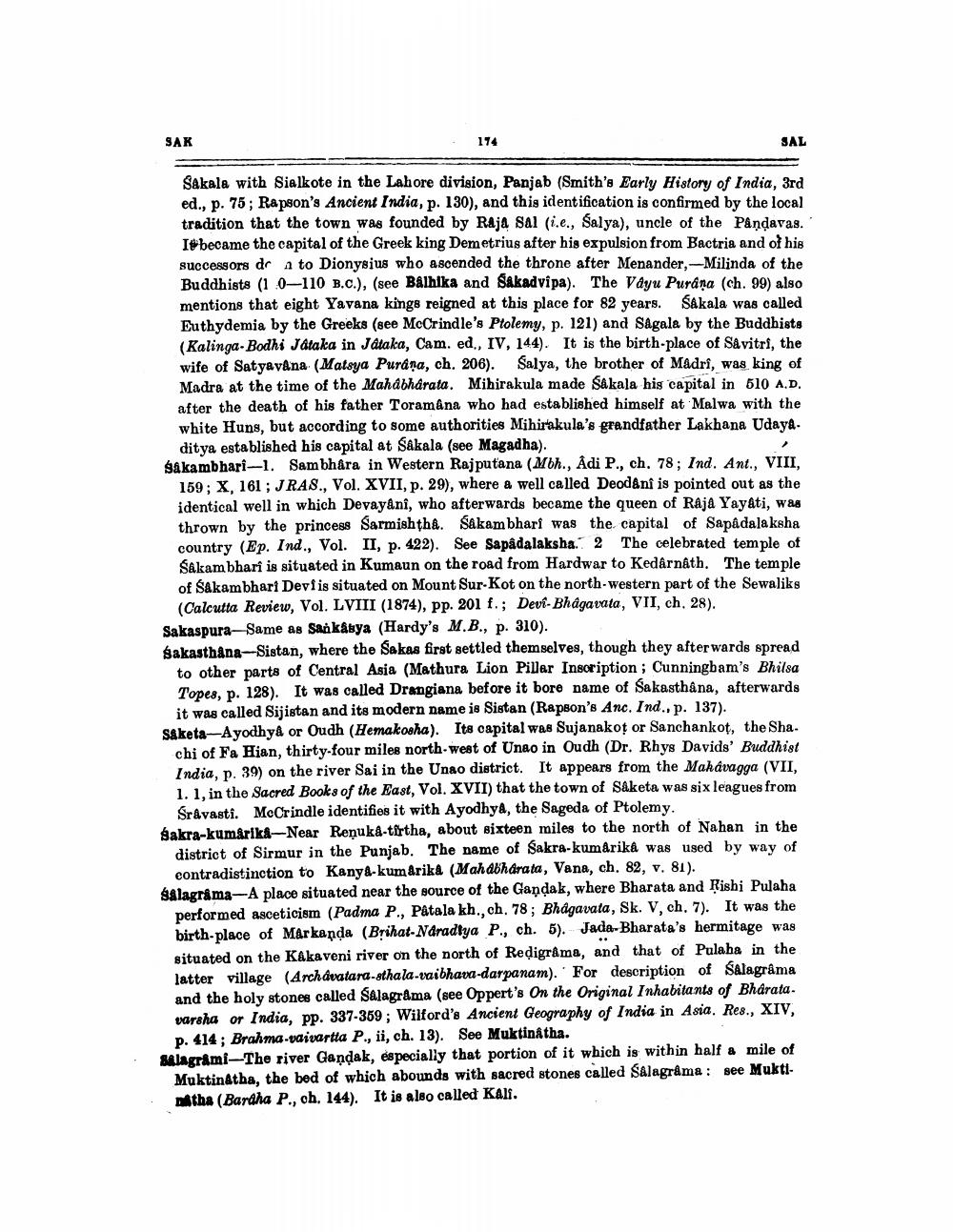________________
SAK
174
SAL
Sakala with Sialkote in the Lahore division, Panjab (Smith's Early History of India, 3rd ed., p. 75; Rapson's Ancient India, p. 130), and this identification is confirmed by the local tradition that the town was founded by Raja Sal (i.e., Salya), uncle of the Pandavas. I#became the capital of the Greek king Demetrius after his expulsion from Bactria and of his successors dr a to Dionysius who ascended the throne after Menander, -Milinda of the Buddhists (1.0-110 B.C.), (see Balhika and Sakadvipa). The Vayu Purana (ch. 99) also mentions that eight Yavana kings reigned at this place for 82 years. Sakala was called Euthydemia by the Greeks (see MoCrindle's Ptolemy, p. 121) and Sagala by the Buddhists (Kalinga- Bodhi Jataka in Jataka, Cam. ed., IV, 144). It is the birth-place of Såvitri, the wife of Satyavana (Matsya Purana, ch. 206). Salya, the brother of Madri, was king of Madra at the time of the Mahabharata. Mihirakula made Sakala his 'capital in 510 A.D. after the death of his father Toramana who had established himself at Malwa with the white Huns, but according to some authorities Mihirakula's grandfather Lakhana Udaya
ditya established his capital at Sakala (see Magadha). gakambhari-1. Sam bhara in Western Rajputana (Mbh., Adi P., ch. 78; Ind. Ant., VIII,
159; X, 161 ; JRAS., Vol. XVII, p. 29), where a well called Deod&ni is pointed out as the identical well in which Devayani, who afterwards became the queen of Raja Yay&ti, was thrown by the princess Sarmishtha. Sakam bhari was the capital of Sapadala ksha country (Ep. Ind., Vol. II, p. 422). See Sapadalaksha. 2 The celebrated temple of Sakam bhari is situated in Kumaun on the road from Hardwar to Kedarnath. The temple of ŠAkambhari Devi is situated on Mount Sur-Kot on the north-western part of the Sewaliks
(Calcutta Review, Vol. LVIII (1874), pp. 201 f.; Devi Bhagavata, VII, ch. 28). Sakaspura-Same as Sankabya (Hardy's M.B., p. 310). gakasthÅna-Sistan, where the Sakas first settled themselves, though they afterwards spread
to other parts of Central Asia (Mathura Lion Pilar Inscription ; Cunningbam's Bhilsa Topes, p. 128). It was called Drangiana before it bore name of Sakasthana, afterwards it was called Sijistan and its modern name is Sistan (Rapson's Anc. Ind., p. 137). Saketa-Ayodhyâ or Oudh (Hemakosha). Its capital was Sujanakot or Sanchankot, the Sha.
chi of Fa Hian, thirty-four miles north-west of Unao in Oudh (Dr. Rhys Davids' Buddhist India, p. 39) on the river Sai in the Unao district. It appears from the Mahavagga (VII, 1. 1, in the Sacred Books of the East, Vol. XVII) that the town of Saketa was six leagues from
Sravasti. MeCrindle identifies it with Ayodhya, the Sageda of Ptolemy. sakra-kumarika-Near Renuk-tërtha, about sixteen miles to the north of Nahan in the
district of Sirmur in the Punjab. The name of Sakra-kumarika was used by way of
contradistinction to Kanye-kumarika (Mahabharata, Vana, ch. 82, v. 81). Salagrama-A place situated near the source of the Gandak, where Bharata and Rishi Pulaha
performed asceticism (Padma P., Patala kh.,ch. 78; Bhagavata, Sk. V, ch. 7). It was the birth-place of Markanda (Brihat-Naradtya P., ch. 5). Jada-Bharata's hermitage was situated on the Kakaveni river on the north of Redigrama, and that of Pulaha in the latter village (Archavatara sthala-vaibhava-darpanam). For description of Salagrama and the holy stones called Salagráma (see Oppert's On the Original Inhabitants of Bharata. varsha or India, pp. 337-359; Wilford's Ancient Geography of India in Asia. Res., XIV,
p. 414; Brahma-vaivartta P., ii, ch. 13). See Muktinatha. Salagråmi-The river Gandak, especially that portion of it which is within half a mile of
Muktinatha, the bed of which abounds with sacred stones called Salagrama: see Muktiatha (Bardha P., oh. 144). It is also called KALS.




